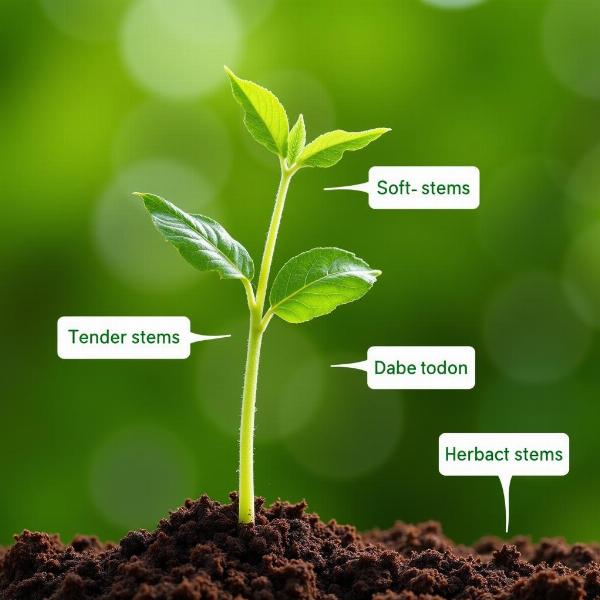Tender stems, a phrase often encountered in botany and cooking, carries a nuanced meaning that can be tricky to translate directly into Hindi. Understanding its various contexts, from describing young plants to culinary instructions, is crucial for accurate interpretation. This article explores the different meanings of “tender stems” in Hindi, providing practical examples and highlighting cultural relevance.
Exploring the Botanical Meaning of “Tender Stems”
In botany, “tender stems” refers to the young, soft, and pliable stems of plants. These stems are usually green and herbaceous, lacking the woody texture of mature plants. The Hindi equivalent of “tender stems” in this context varies depending on the specific plant and regional dialect. Common terms include कोमल तना (komal tana), which literally translates to “soft stem,” and नर्म तना (narm tana), meaning “tender stem.” Other options might include हरी डालियाँ (hari daliyan) for “green branches” or नई टहनियाँ (nayi tahniyan) for “new twigs,” depending on the plant’s structure.
 Komal Tana Botanical Example
Komal Tana Botanical Example
For example, when discussing the tender stems of spinach, you might use पालक के कोमल तने (palak ke komal tane). This specificity ensures accurate communication and avoids confusion.
Culinary Uses and Hindi Equivalents
In cooking, “tender stems” usually refers to the edible, young stems of vegetables like asparagus, broccoli, or bok choy. The emphasis is on their delicate texture and suitability for consumption. Here, the Hindi translation focuses on edibility and tenderness. कच्चे तने (kachche tane), meaning “raw stems” or मुलायम तने (mulayam tane) meaning “soft stems” are often used. Sometimes, the term नाज़ुक तने (nazuk tane) which means “delicate stems” might be appropriate.
For instance, a recipe might instruct you to use the ब्रोकली के मुलायम तने (broccoli ke mulayam tane), emphasizing the tender, edible part of the broccoli.
Understanding Regional Variations and Context
It’s important to note that the Hindi translation of “tender stems” can vary depending on the region and specific context. Local dialects may have their own unique terms, and the specific plant being discussed plays a crucial role in selecting the appropriate translation. When in doubt, it’s always best to consult with a native Hindi speaker or refer to a reliable Hindi-English dictionary.
What are some common misconceptions about tender stems?
Often, people confuse tender stems with mature, woody stems, leading to incorrect culinary preparations or botanical misinterpretations. Understanding the difference is crucial for both gardeners and cooks.
Why is it important to identify tender stems correctly?
Proper identification of tender stems is essential for successful gardening, ensuring that you prune and care for your plants correctly. In cooking, it ensures that you select the most palatable and digestible parts of vegetables.
How can I tell if a stem is tender?
Tender stems are typically green, flexible, and easily broken. They lack the tough, woody texture of mature stems.
Conclusion: Navigating the Nuances of “Tender Stems” in Hindi
Whether discussing botany or cooking, understanding the context and regional variations is crucial for accurately translating “tender stems” into Hindi. This article has explored various possible translations, including komal tana, narm tana, mulayam tane, and nazuk tane, highlighting their specific applications. By considering the context and consulting reliable resources, you can confidently navigate the nuances of this phrase and communicate effectively in Hindi.
FAQ
-
What is the most common Hindi word for “tender stems”? The most common Hindi words are komal tana (कोमल तना) and narm tana (नर्म तना).
-
Does the meaning change depending on the context? Yes, the meaning and appropriate translation can vary depending on whether the context is botanical or culinary.
-
Are there regional variations in the Hindi translation? Yes, regional dialects may have specific terms for “tender stems.”
-
Why is it important to understand the different translations? Understanding the different translations allows for accurate communication and avoids misinterpretations.
-
Where can I find more information on Hindi translations of botanical terms? Reliable Hindi-English dictionaries and botanical glossaries are helpful resources.
Meaning-Hindi.in offers professional translation services specializing in various fields, including business, legal, technical, website localization, and educational materials. Our expert linguists ensure accurate and culturally sensitive translations, bridging the language gap for diverse communication needs. We also offer expedited translation services for urgent requests. Contact us at [email protected] or call +91 11-4502-7584 to discuss your translation requirements. Meaning-Hindi.in is your trusted partner for all your Hindi translation needs.